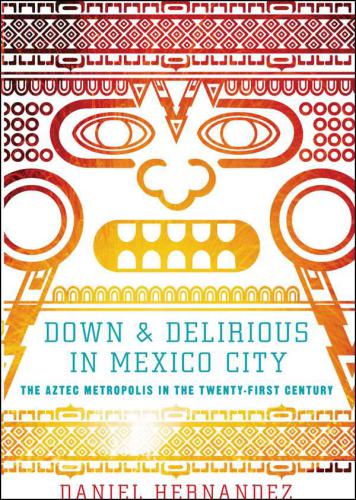
Down and Delirious in Mexico City
The Aztec Metropolis in the Twenty-First Century
کتاب های مرتبط
- اطلاعات
- نقد و بررسی
- دیدگاه کاربران
نقد و بررسی

December 13, 2010
In 2002, just out of U.C. Berkeley, Hernandez headed to Mexico City to trace his cultural roots. Five years later, he returned there as a journalist and immersed himself in the bewildering subcultures of the western hemisphere’s largest city. His explorations take him from fashion runways and cocaine after-parties, the street brawls of punk and emo kids, to the teeming festival of Mexico’s national icon, the Virgin of Guadalupe. As Hernandez wanders the labyrinths of the city, he also investigates his own uncertain identity as the American-born child of Mexican parents. Hernandez covers a lot of ground in his study of the city, maybe too much. Skimming from scene to scene, he doesn’t settle anywhere long enough to write with an insider’s perspective. Because of this, the observations rarely transcend the journalistic generalities found in the average feature story. Hernandez’s personal quest, which could have centered the book, never becomes compelling. While informative, his book often reads like a bulked up tour guide.

November 15, 2010
A collection of travel essays exploring Mexico City's diverse culture.
In his debut, Los Angeles Times "La Plaza" blogger Hernandez provides firsthand accounts of the people and traditions of one of the world's largest, and most chaotic, cities. "Life in Mexico City," he writes, "is a contact sport. It might be scary at first, unforgiving, violent, but to really grasp it, you gotta get in, release all inhibitions, all cultural blinders. You have to get down, and play." The author does just that, partaking in drugs, alcohol, sweat lodges and a religious pilgrimage in an effort to better understand his roots. Born in San Diego to Mexican parents, Hernandez struggled to come to grips with his heritage. When explaining his situation to a stateside Mexico City native, the girl offhandedly replied that Hernandez was "not really Mexican," spurring him to travel to Mexico to find out for himself. Throughout his journeys, the author recounts a land of unique people, many of whom in the younger generation regularly peg themselves as bandas (a term "[e]voking youth, rock-n-roll, and resistance") and other self-selecting groupings. Yet beyond these emerging subcultures remains a far older tradition, deeply rooted in religious and spiritual purification. Hernandez attempts to rekindle his spiritual side by taking a pilgrimage to the sight of the Virgen de Guadalupe's final appearance. After becoming overwhelmed by the fervent crowds, he backed out, disappointedly noting that a "real Mexican...would have seen the pilgrimage all the way through." In a second attempt at spiritual rejuvenation, the author participated in a temazcal—a makeshift sweat lodge notorious for pushing its inhabitants to their physical limits. Overcome by the heat, a downtrodden Hernandez was forced to exit the lodge prior to the conclusion of the ritual—yet another example of his valiant, though ultimately unsuccessful, attempts at assimilation.
An intimate portrait of a land, its people and its customs.
(COPYRIGHT (2010) KIRKUS REVIEWS/NIELSEN BUSINESS MEDIA, INC. ALL RIGHTS RESERVED.)

January 1, 2011
Hernandez (contributing blogger, La Plaza, Los Angeles Times; former staff writer, LA Weeky), a Mexican American writer from San Diego, searches for cultural roots in Mexico's capital while turning a hipster's eye (at times amplified with alcohol and drugs) on the thriving subcultures of Mexico City. He begins the book with a modern-day pilgrimage to the Basilica of Our Lady of Guadalupe, outside the city center. He introduces readers to the emo subculture and immerses himself with Mexican punks, dabbles with the Santa Muerte (holy death) cult, and partakes in a sweat lodge. Hernandez also covers the frightening air pollution of Mexico and the even more frightening kidnappings and crime of the metropolis. VERDICT This book is clearly not sponsored by the Mexican government's tourism office, and don't even think of using it as a guide to your own explorations into rough capital neighborhoods. Some readers may tire of the profiled slackers' aimless pursuits of decadence, but those with an interest in modern-day Mexico or subcultures will appreciate Hernandez's youthful memoir.--Lee Arnold, Historical Society of Pennsylvania, Philadelphia
Copyright 2011 Library Journal, LLC Used with permission.

December 15, 2010
As a journalist in Mexicos capital from 2007 to 2010, Hernandez collected experiences and impressions for this collection of essays largely about the citys youth subcultures. Some pieces diverge into discussions of the general features of Mexico City, such as its smog and its plague of kidnapping, but Hernandez, not long out of college, chiefly immersed himself in the haunts and attitudes of 20-year-olds. He fell in with one group on pilgrimage to the shrine of the Virgin of Guadalupe, the first of several foci of veneration that Hernandez inspects (Saint Death and sweat lodges are two others). Exploring the street scenes of the massive metropolis, Hernandez in turn befriends music fanatics; emos (as in emotional ones); hard-partying, fashion-conscious scenesters; denizens of beer bars; and punks. In their microsociologies, Hernandez observes peoples styles of self-expression and muses about their self-identities as quasi-tribal responses, akin to survival modes amid the chaotic citys ever-impinging potential for danger (one friend dies). A perceptive reporter, Hernandez renders a gritty portrait of contemporary Mexican youth.(Reprinted with permission of Booklist, copyright 2010, American Library Association.)

























دیدگاه کاربران